- Home
- Encyclopedia
- Asa Mercer and The Banditti of The Plains
Asa Mercer and The Banditti of the Plains
The horses galloped for the Wyoming-Colorado border, pulling a wagon loaded with several hundred copies of a book, at least one of which had a bullet hole in it. Was this seditious literature? Dangerous information? It all depended which side you were on.
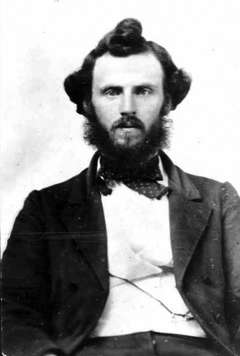
"[T]his book … has a curious habit of either disappearing suddenly and forever, or else of disappearing for a while and then, when returned to the … [library] shelf, showing the marks of surgical operations." wrote Philip A. Rollins, the owner of the copy with the bullet hole, when he sent it to the Princeton University Library in 1923.
This is all quite sensational, but is it true? That will probably never be known. Accounts of what happened after Asa Shinn Mercer published The Banditti of the Plains in August 1894 are too disparate and mostly not well documented.
In his active and colorful career, Mercer was jailed twice, beaten up at least twice, had his property confiscated several times—sometimes legally, sometimes not—and in general managed to put himself time and again in controversy’s rocky path.
Young adulthood
Born to Aaron Mercer and Jane Dickerson Mercer on June 6, 1839, in Princeton, Ill., Asa Shinn Mercer graduated from Franklin College, a Presbyterian school in New Athens, Ohio, in 1860. In June of the next year, he followed his two older brothers, Thomas and Aaron, to Washington Territory. For the next two years, he taught at the brand-new University of Washington and also served briefly as acting president.
In 1863, he conceived the project for which he is probably best known outside of Wyoming: Observing that the ratio of men to women among white settlers in the Pacific Northwest was 9 to 1, he decided to recruit eligible women from the East Coast to travel west, with the plan to marry and help populate the area. Historians dubbed this effort "Mercer's Belles."
On July 15, 1866, Mercer married Annie E. Stephens in Seattle. His new wife, a staunch Catholic, was the daughter of John Stephens, owner of a hat factory in Philadelphia; Annie and her younger sister, Mamie, were part of the original group of Mercer's Belles. During their nearly 34-year marriage, the Mercers had eight children, five of whom survived childhood.
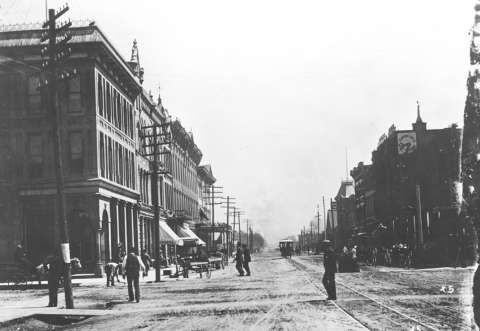
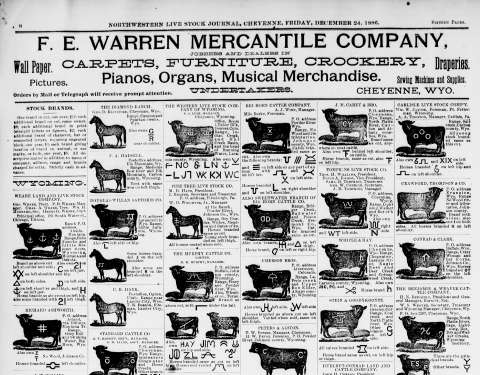
The same year he married, Mercer was appointed deputy collector for the U.S. Custom House in Astoria, Ore. While in this job, he was accused of smuggling by the U.S. government. This was the first time he was jailed. However, the government's case failed after two trials in which the juries could not agree, plus the added problem—so common in the raw west—of mysteriously missing witnesses.
The Northwestern Live Stock Journal
While the Mercers were still in Oregon, Asa started his first newspaper, the Oregon Granger, on Dec. 4, 1873, an effort that lasted less than a year. By the end of 1878, the Mercers had moved to Sherman, Texas, just south of the Red River, about 65 miles north of Dallas. There, Asa edited—though did not own—the Sherman Courier. In the lively journalistic culture of the state, Mercer eventually did own and edit five newspapers, from 1880 through about the middle of 1883.
In August of that year, the Mercers moved to Cheyenne, Wyo., and on Nov. 25, 1883, Asa published the first issue of his weekly Northwestern Live Stock Journal. He began with eight pages, but by the following spring, that number had doubled. The print run was about 5,000 copies per week in 1884, though the paid circulation was somewhat less. For about five years the Journal chugged quietly along, publishing livestock industry news from at least 10 states and territories, including Texas and California. Mercer also wrote editorials about pending legislation and other issues affecting cattle ranchers.
The back pages were filled with ranch advertisements showing each ranch’s horse and cattle brands. By fall 1886, there were more than 250; 135 of these from Wyoming. Brand ads, paid for a year in advance, were less expensive to produce than the rest of the paper because they required no new typesetting from one issue to the next. Mercer charged $12 per ad per year, and this steady income, with its relatively low overhead, almost certainly helped the Journal in its success.
Mercer also enjoyed the support of the powerful and then-prosperous Wyoming Stock Growers Association (WSGA), and in spring 1884—no more than half a year after he began publishing—the association ordered 150 copies to be sent to members of Congress. By early 1886, Mercer's payroll was almost $160 per week for 10 employees, the financial high point of the Journal.
Mercer's success depended on his support of the WSGA and, as conflict heated up between land settlers and the early cattle barons, who wanted to continue their unrestricted grazing on an unfenced range, he left no doubt about where he stood. After Ella Watson and James Averell were lynched near the Sweetwater River in July 1889, Mercer wrote an editorial so outrageous in content and so unabashed in tone that few historians have failed to quote at least part of it.
"There is but one remedy [to the rustling problem], and that is a freer use of the hanging noose,” Mercer wrote. “Cattle owners should organize and not disband until a hundred rustlers were left ornamenting the trees or telegraph poles of the territory. The hanging of two culprits merely acts as stimulus to the thieves. Hang a hundred and the balance will reform or quit the country. Let the good work go on, and lose no time about it." Many of Mercer’s Live Stock Journal's issues have been lost, but in a common practice of the times, this editorial was quoted in the Sept. 7, 1889, Big Horn Sentinel.
A swift about-face
In light of his subsequent behavior, Mercer's avowed sentiments cannot be ignored. In spring 1892, after prominent members of the WSGA attempted to execute their megalomaniac plan to invade Johnson County and kill as many as 70 supposed rustlers there, the press statewide exploded into debate. Back then, most newspapers represented political parties, and by definition the Northwestern Live Stock Journal had always been Republican. Therefore, it reflected the politics of the majority of its patrons and presumably the convictions of its editor as well.
But no more: In a swift about-face, Mercer not only condemned the actions of the Johnson County invaders, he joined the Democratic party in campaigning during the election season of 1892. No one knows why he switched sides; what is known, to some degree, are the details of what he did—and also how his enemies retaliated.
On May 14, 1892, less than six weeks after the Johnson County invasion, the Cheyenne Daily Leader excerpted a recent editorial by Mercer: "The Journal will uphold all cattlemen in every legitimate effort to protect their herds, but it will not pronounce in favor of an illegal and mercenary plan to aid the few at the expense of the many."
In June, Col. Emerson H. Kimball, editor of the Douglas Graphic and longtime critic of the WSGA and Mercer's newspaper as well, was jailed for criminal libel against several members of the invading force and their supporters. When Mercer offered to sign Kimball's bail bond for $500, most of his brand advertisers withdrew their ads immediately. Mercer ran his next issue with blank spaces captioned "Boycotted for Opinion's Sake."
Later that summer, Mercer attacked the powerful John Clay, Jr., then president of the WSGA and manager of the huge Swan Land and Cattle Company. On Aug. 24, 1892, the Cheyenne Daily Sun quoted the Journal under the Sun's headline, "Mercer's Malicious Attack:" "Too great a coward himself to … fight, … [John Clay, Jr.] sent one of his hired men and contributed to the extermination fund in cheap talk if not in shining shekels."
Shortly thereafter, Charles A. Campbell, one of the invaders and also a cattle buyer for Clay, concluded that Mercer had been referring to him as the hired man. Campbell visited Mercer's newspaper office and hit him in the face. Mercer bled heavily from a cut on his eyebrow, but was not seriously hurt.
On Oct. 14, 1892, Mercer dropped the biggest bombshell of all by publishing, word-for-word, the statement known as "Dunning's Confession." George Dunning, a mercenary from Idaho who participated in the invasion, wrote a 44-page longhand account of the plans for the invasion as well as the events themselves. In so doing, he implicated most of the Wyoming participants, in particular the expedition's planners and leaders.
The consequences exploded onto Mercer. Two days after publication, he traveled to Chicago as an alternate commissioner for Wyoming for the World's Fair, to meet with the other commissioners. The fair was scheduled to open the following year. Chicago was John Clay's home town, and Clay filed a libel action against Mercer, who was briefly jailed in Cook County, Ill. However, since Mercer's anti-Clay editorial had not been published in Cook County, action could not proceed against him there, and he was released.
While Mercer had been in Chicago, a legal judgment of the St. Louis Type Foundry was executed against him in Cheyenne in a case that had been pending for a year. The sheriff seized the Journal's property, including copies of the October 14 issue, but 1,400 had already been sent to subscribers. Apparently Mercer's equipment was returned, since it was in his wife's name; he continued publishing the Journal for another nine months before shutting down in summer 1893, as reported in the July 20, 1893, Cheyenne Daily Leader.
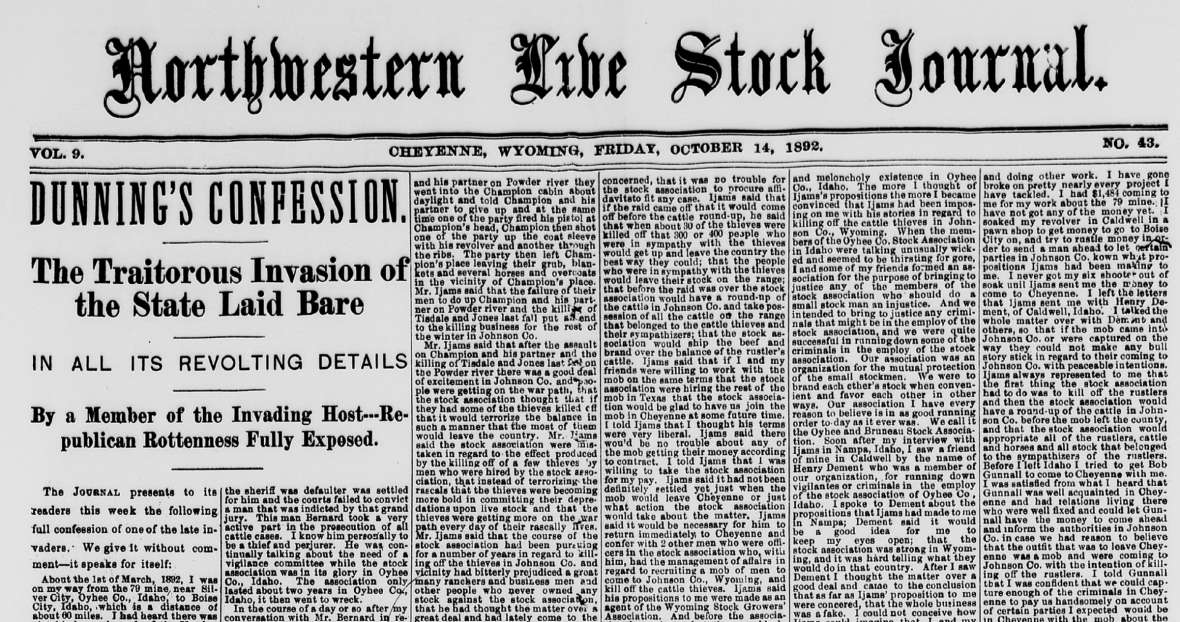
The Banditti of the Plains
Mercer's contribution to Wyoming history and literature/journalism lies not in his nearly 10-year production of the Northwestern Live Stock Journal—although “Dunning's Confession” was significant—but in the project he completed in 1894: an account and condemnation of the Johnson County invasion, titled The Banditti of the Plains, or The Cattlemen’s Invasion of Wyoming in 1892 [The Crowning Infamy of the Ages].
Historians agree information in Banditti is correct, with a few exceptions such as Mercer’s theorizing about the motive for the May 10, 1892, ambush and murder of George Wellman, a popular ranch foreman in Johnson County. Wellman's murder had little or nothing to do with the Johnson County conflict, though Mercer blamed it on an unsuccessful conspiracy among the invaders to provoke the federal government to declare martial law.
The first part of The Banditti, "Introductory," is useful to the modern reader for its description of the early cattle industry, before fences; and the brief history of the cattle boom in Wyoming. In Chapter 7, in a section headed "Official Correspondence," Mercer reprints 14 revelatory telegrams, mostly exchanged between high officials bent on protecting the invaders. These officials included Acting Gov. Amos W. Barber and President Benjamin Harrison. Dunning's entire confession appears in an appendix.
Almost from the beginning, the book's publication spawned rumors and wild stories equal to the galloping plot of any western.
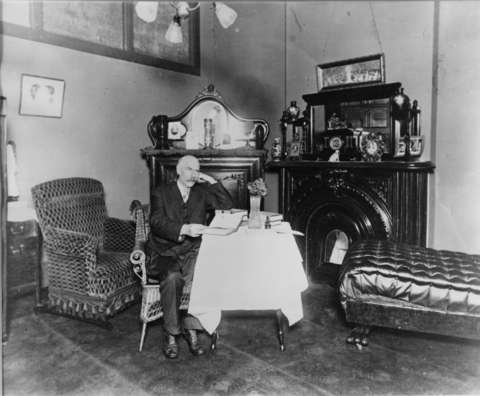
The facts are few, however. Two reviews and one editorial, all published in newspapers, have survived. The Aug. 20, 1894, Denver Daily News commented, "The book is written in a free, flowing journalistic style, but with a pen dipped in gall. It does not mince words … [and] is a timely contribution to the history of the West. That it recites the facts of a deep and damning crime detracts not the least from its value."
By contrast, the Cheyenne Sun, in its review published Aug. 22, 1894, accused Mercer of compiling the book in a "careless and reckless spirit," citing Mercer's claim that Dr. Charles Penrose, a Philadelphia surgeon who traveled partway with the invaders, carried a surgical case belonging to Acting Gov. Barber. Barber was also a physician.
This is a point that Mercer has been accused of either lying or being mistaken about. Mercer's biographer, Lawrence M. Woods, contends that Penrose's initials were on the case, therefore it was his. Helena Huntington Smith, author of The War on Powder River, says nothing about whose initials were on the case, but states that Barber lent it to Penrose. This question, though incidental to the history of the Johnson County War, is nonetheless relevant to Mercer's story because it sheds light on possible inaccuracies in Banditti. Additionally, no source contests the fact that Barber and Penrose attended college together and were friends, and that Barber encouraged Penrose to accompany the invaders.
The Sun review continued, "The object of these statements is to fasten on the governor complicity in the invasion." Information then available had already confirmed Barber's involvement, however.
A week after the Sun's review, the Denver Daily News published an editorial defending Mercer, referring to Banditti as "an accurate and official record of the raid of arson and murder to which Wyoming was subjected by the Cheyenne cattle ring." The rest of the article is a commentary on the Johnson County conflict and the crookedness of the invaders.
The first printing of the book was probably done in Denver in August 1894. Likely it was 1,000 copies. Asa and his son Ralph sold books in Cheyenne and also toured the northern part of the state to sell more books. Few of these first editions have survived, leading to endless speculation about what became of them. The most enduring story is that members of the invading force and their relatives purchased, borrowed or stole the book in order to destroy as many copies as possible. Another persistent tale is that the invaders sued for libel and the court ordered the edition impounded, pending the outcome. Supposedly, while the books were in the court's custody, some were stolen and smuggled to Denver. However, no records exist of any such lawsuit in Laramie County from August through November 1894.
Nixon Orwin Rush did a study of the fate of the book, publishing his findings in 1961 in a 67-page booklet, Mercer's Banditti of the Plains: The Story of the First Book Giving an Account of the Cattlemen's Invasion of Wyoming in 1892. However, historian Louis Gould comments that Rush's work must be used with caution, as it is "poorly researched and inaccurate on matters of fact and interpretation."
Possibly the more reliable parts of Rush's study are his interviews with two of Mercer's children, Ralph Mercer and Janet Mercer Webb. Both siblings agree that the book was printed in Denver, and Mrs. Webb stated that there was a second printing, also in Denver, and these books were burned before they could be shipped.

Rush also publishes a letter to him from historian and editor Agnes Wright Spring, in which she recalled a conversation with the woman in charge of the estate of Cheyenne attorney Hugo Donzelman, who was a known supporter of the WSGA and aided their more illegal activities. This woman told Spring that Donzelman somehow obtained some unbound copies of Banditti, put them in his basement and hired a janitor to burn them. Supposedly the janitor burned most of them but saved out a few to sell. This is a good story, but like many of the others, impossible to prove.
Two of Mercer's great-grandsons have their own recollections. Allen Mercer remembers that "my great uncle Ralph told my father that … [Asa Mercer, Sr.] sent him and his brother, Asa Jr., out in Cheyenne to buy back copies" to keep them from being burned. However, continued Allen, a few days later, someone raided Mercer's office, pulled out a bunch of papers, books and equipment, made a pile of it in the street, poured on some kerosene and lit it up.
Regarding this story, Allen Mercer's second cousin, John Mercer, observed, "I doubt they [the Mercer family] had the money to buy anything." On reflection, John added, "I remember all the [family] stories about how … [copies of Banditti] disappeared. They did indeed disappear at an alarming rate, and when I asked Grandpa [Ralph] about a copy of the book he once had, all he said was, 'Somebody borrowed it and didn't bring it back.'" John Mercer further recalls that "a shipment from Denver was printed up"—possibly the legendary second printing—"and never did arrive in Cheyenne."
No newspaper reports of the attack or fire recalled by Allen Mercer's great-uncle Ralph have survived, nor does Rush mention the episode. However, in Chapter 4 of his study, "Burning of Copies and Mercer's Arrest," he cites other stories of the book being seized and burned. Many of these appear difficult to verify.
Woods observes that stories that the cattlemen seized and burned the book lack foundation. However, he notes that few first editions have survived and acknowledges that they could have been burned. Further adding to the mystery is Helena Smith's account: Five hundred copies of the first printing were "said to have been sent" to Sheridan, but only got as far as Buffalo. These 500 books stayed in the Burlington railroad station in Sheridan until 1909. After that, a local stationer "presumably" sold them. Rush also tells a version of this story, naming "a reliable source in Sheridan."
Currently, at least 32 libraries in the U.S. and Canada have first editions, and as of June 2016 five are listed for sale online, with prices ranging from $1,250 to more than $6,000. This suggests that the original book is extremely rare. It is unlikely that anyone will ever learn where most of the remaining 950-plus copies are, or whether they were destroyed.
Later years
In spring 1895, the Mercers moved to Hyattville, Wyo., and, with their now-grown children, filed on 800 acres of homestead land on Paint Rock Creek. A few months later, they were victims of what was either an accident or an attack: On July 11, the Cheyenne Daily Sun-Leader excerpted a paragraph from the Buffalo Voice, including the report that "[Mercer] had his house nearly completed and while he and the boys had gone to the mountains for a load of logs, some one set fire to the house and burned it down." We will probably never know whether this was arson and if so, was further retaliation for the publication of Banditti.
Apparently undaunted, the Mercers must have rebuilt their house, because they went on to plant hay and begin cattle ranching. In 1909, the enterprise became the Mercer Brothers Land and Livestock Company, Inc., issuing 1,000 shares. The ranch, the largest on Paint Rock Creek by 1916, is still in the family today. In the fall of 1900, Annie Mercer died at the home of her daughter, Janet Webb. She was about 60 years old. Asa outlived her by 17 years, dying on Aug. 9, 1917, at the age of 78.
Helena Smith, discussing the aftermath of the Johnson County invasion and Mercer's role in it, comments that "[w]ithout Mercer and his opponents' blundering persecution the 'war' in Johnson County would have been a half forgotten local incident. Instead, largely because of him, it became immortalized in iniquity."
The Banditti of the Plains is now widely available in the reprint edition issued by the University of Oklahoma Press in 1954. Previously, three other editions were issued by various individuals and presses, but the University of Oklahoma edition is the most common of what has become a recognized classic of Wyoming history, despite the book’s bias and occasional errors.
(Editor’s note: Publication of this and seven other articles on Wyoming newspapering is supported in part by the Wyoming Humanities Council and is part of the Pulitzer Prizes Centennial , a joint venture of the Pulitzer Prizes Board and the Federation of State Humanities Councils in celebration of the 2016 centennial of the prizes. The initiative seeks to illuminate the impact of journalism and the humanities on American life today, to imagine their future and to inspire new generations to consider the values represented by the body of Pulitzer Prize-winning work. For their generous support for the Campfires Initiative, the council thanks the Andrew W. Mellon Foundation, the Ford Foundation, Carnegie Corporation of New York, the John S. and James L. Knight Foundation, the Pulitzer Prizes Board, and Columbia University.)
Resources
Primary Sources
- Wyoming Newspapers. Accessed March 2-4, 2016, March 22, 2016, and April 4, 2016, at http://newspapers.wyo.gov:
- Big Horn County Rustler, Sept. 15, 1911.
- Big Horn Sentinel, Sept. 7, 1889.
- Cheyenne Daily Leader, May 14, 1892; June 8, 1892; June 16, 1892; July 20, 1893.
- Cheyenne Daily Sun-Leader, July 11, 1895.
- Cheyenne Daily Sun, July 26, 1884; Aug. 2, 1884; June 9, 1892; Aug. 24, 1892; Oct. 9, 1894.
- Cheyenne Sun, Aug. 22, 1894.
- Northwestern Live Stock Journal, June 27, Dec. 3, 1884; April 10, 1885; Dec. 3, 10, 17, 24, 1886; Jan 7-Dec. 2, 1887; Oct. 14, 1892.
- Denver Daily News, Aug. 20, 1894; Aug. 29, 1894. Quoted in Rush, Nixon Orwin. Mercer's Banditti of the Plains: The Story of the First Book Giving an Account of the Cattlemen's Invasion of Wyoming in 1892. Tallahassee, Fla.: The Florida State University Library, 1961, 2-4, 44-45.
- Mercer, Allen. Telephone interview with the author. March 14, 2016.
- Mercer, John. Telephone interview with the author. March 15 and 16, 2016.
Secondary Sources
- Davis, John W. Wyoming Range War: The Infamous Invasion of Johnson County. Norman, Okla.: University of Oklahoma Press, 2010, 76-77, 176, 210, 216, 230-232, 240-242, 270, 277.
- Gould, Lewis L. "A.S. Mercer and the Johnson County War: A Reappraisal." Journal of the Southwest 7, no. 1 (Spring 1965): 5-20.
- Mercer, Asa S. The Banditti of the Plains: or The Cattlemen's Invasion of Wyoming in 1892 [The Crowning Infamy of the Ages]. Norman, Okla.: University of Oklahoma Press, 1954, xiii-xv, 5-15, 74-82, 151-195.
- Rush, Nixon Orwin. Mercer's Banditti of the Plains: The Story of the First Book Giving an Account of the Cattlemen's Invasion of Wyoming in 1892. Tallahassee, Fla.: The Florida State University Library, 1961, 2-4, 7-13, 25-26, 44-45.
- Smith, Helena Huntington. The War on Powder River: The History of an Insurrection. Lincoln, Neb.: University of Nebraska Press, 1966, vii-viii, 133, 191, 214, 217, 252-261, 265-280, 306 note 9.
- Woods, Lawrence M. Asa Shinn Mercer: Western Promoter and Newspaperman, 1839-1917. Western Frontiersmen Series, 30. Spokane, Wash.: Arthur H. Clark Company, 2003, 13-93, 109-113, 117-160, 173-199, 224.
For Further Reading and Research
- Northwestern Live Stock Journal (microfilm), University of California-Berkeley, Accessed April 19, 2016, at http://www.lib.berkeley.edu/using-the-libraries/interlibrary-loan-photoduplication: Feb. 1, March 21, April 4, April 18-May 2, 16, June 6, July 4, Aug. 15-22, Sept. 12, Oct. 10-Nov. 14, 1884; Feb. 27, May 22-June 12, June 26-July 10, Aug. 7-Dec. 25, 1885; Jan. 1-April 16, May 7-14, May 28, July 2, 16, Sept. 17-Dec.24, 1886; Jan. 7-28, Feb. 11-25, March 11-May 13, May 27-June 17, July 1, July 22-Aug. 5, Aug. 19-Sept. 2, Sept. 16, Oct. 14-21, 1887; Feb. 10, Aug. 31-Nov. 16, Nov. 30-Dec. 7, Dec. 21, 1888; Jan. 11-18, Feb. 1, Feb. 15-April 19, May 3-June 21, 1889; Jan 10, Oct. 3, 1890; Sept. 2, 1892.
- Northwestern Live Stock Journal (microfilm), Wyoming State Archives, Cheyenne, Wyo.: Feb. 15, March 28, April 4, 11, Aug. 15, Dec. 5, 1884; April 17, May 29, Oct. 16, 1885; Aug. 20, 27, Oct. 1, 29, 1886.
Illustrations
- The early portrait of photo of Asa Mercer is from Wikipedia. Used with thanks.
- The image of the first-edition title page of The Banditti of the Plains is from a copy in the collections of the Buffalo Bill Center of the West. Used with permission and thanks.
- The photo of Mercer with the books is from the Wyoming State Archives. Used with permission and thanks.
- The images of 1886 and 1892 pages of Mercer’s Northwestern Live Stock Journal are from Wyoming Newspapers, a service of the Wyoming State Library. Used with thanks.
